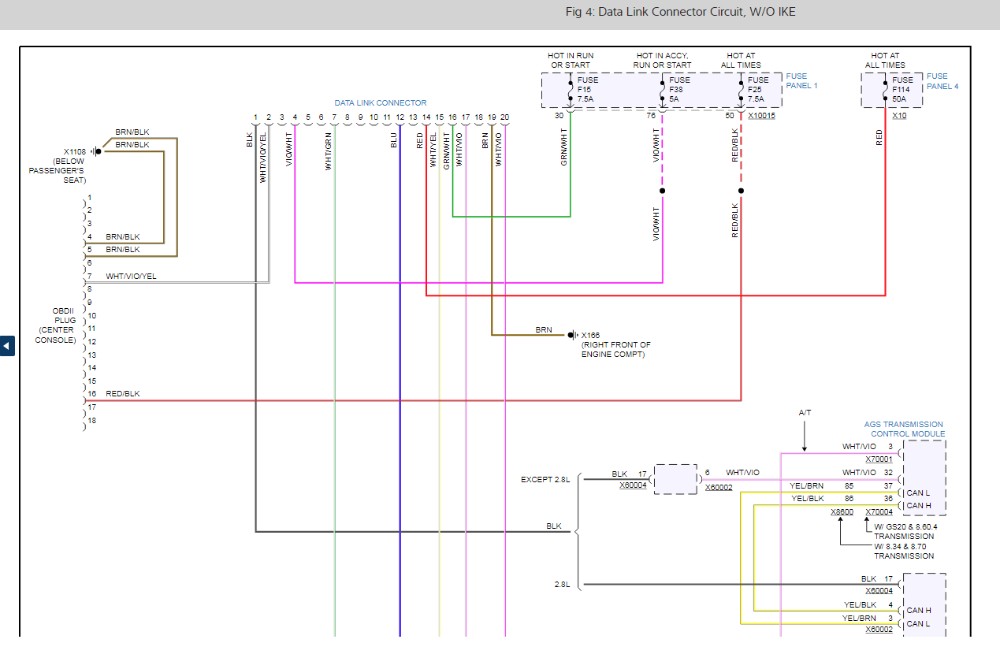Diagnosing issues on a classic BMW like the 1999 528i (E39 generation) requires the right tools and knowledge. If you’re facing communication problems when trying to connect with your car’s computer using an OBDII scanner tool, you’re in the right place. This article delves into a specific scenario encountered while working on a 1999 BMW 528i with a 2.8L DOHC engine (M52 TU) and base instrument cluster, where communication with the engine control module (DME) is failing through both the OBDII and 20-pin diagnostic connectors.
Understanding the Diagnostic Connectors on a 1999 BMW 528i
The 1999 BMW 528i, like many vehicles of its era, is equipped with multiple diagnostic connectors. It’s crucial to understand these to effectively use your OBDII scanner tool and troubleshoot communication issues.
- OBDII Plug (16-pin): This is the standard OBDII connector, typically located under the dashboard on the driver’s side, near the left kick panel. It’s designed for generic OBDII scanner tools to access basic diagnostic information as mandated by OBDII regulations.
- 20-Pin Data Link Connector: BMW also included a proprietary 20-pin diagnostic connector under the hood, usually near the right front strut tower. This connector provides access to more in-depth, BMW-specific diagnostic data and systems.
Note: The image above is a generic emoticon placeholder. In a real article, we would embed a relevant image of a 16-pin OBDII connector.
Symptoms and Initial Checks for OBDII Communication Failure
In this particular case, the 1999 BMW 528i starts, idles, runs, and drives, but exhibits a misfire. More critically, attempts to communicate with any module on the bus using various OBDII scanner tools through both the 16-pin OBDII and the 20-pin connectors are unsuccessful.
Initial troubleshooting steps are essential to rule out common causes before suspecting more complex issues. Here’s what has been done so far:
- Fuse Inspection: All fuses in the glove box and the trunk’s rear power distribution box have been checked and are confirmed to be in good condition. Fuses are crucial for powering the diagnostic systems, and a blown fuse can easily prevent communication.
- Multiple OBDII Scanner Tool Tests: Three different OBDII scan tools were tried on the 16-pin OBDII connector. None could establish communication with the DME or BMW’s D-bus (diagnostic bus). This indicates a potential issue beyond just a single scanner tool incompatibility.
- Mac Mentor (Generation 3) on 20-Pin Connector: A Mac Mentor, a more advanced scan tool, was used on the 20-pin connector. Attempts to communicate using both generic OBDII protocols and enhanced, manufacturer-specific protocols also failed. This further points to a deeper communication problem within the vehicle’s diagnostic system.
- 20-Pin Connector Voltage Check: Pin 2 of the 20-pin connector was checked for voltage during startup. While 12V was present for approximately 10 seconds upon starting, it then dropped to 0V. This behavior could indicate a problem with the power supply or a control module related to the diagnostic system.
Diving Deeper: BUS System Analysis and D-Bus Voltage
To further investigate the communication failure, the BUS systems were examined:
- CAN Bus Scoping: The CAN (Controller Area Network) bus, which facilitates communication between the transmission control module (TCM) and the DME, was scoped at pins 3 and 4 of connector X60002 on the DME. The readings showed normal CAN H voltage (2.5V – 3.5V) and CAN L voltage (2.5V – 1.5V), with CAN H and CAN L signals mirroring each other as expected. This suggests the CAN bus itself is likely functioning correctly.
- D-Bus Voltage Measurement: Pin 7 (BMW’s diagnostic bus – D-bus) on the 16-pin OBDII connector was tested using a graphing multimeter. A constant 12V was present at idle. However, when an OBDII scanner tool (connected to the 16-pin connector) attempted to communicate, the voltage on pin 7 fluctuated between 12V and 0V a few times before returning to a steady 12V. Subsequently, the scan tool displayed a “make sure ignition is on and scan tool is properly connected” message. This fluctuating voltage during communication attempts suggests a potential issue with the D-bus or the DME’s ability to respond.
Isolating Potential Gateway Issues: IKE Disconnection
The Instrument Cluster Electronics (IKE) module often acts as a gateway in BMW diagnostic communication systems. To rule out the IKE as the source of the communication problem, it was disconnected. Despite disconnecting the IKE, communication with the DME on pin 7 of the OBDII connector remained unsuccessful. This step helps narrow down the potential fault, suggesting the issue is likely not related to the IKE gateway function.
Suspecting DME Failure and Seeking Further Guidance
Based on the comprehensive troubleshooting steps taken – including fuse checks, multiple scanner tool tests, voltage measurements, BUS system analysis, and IKE disconnection – the most probable cause of the no-communication issue with the 1999 BMW 528i is a faulty DME (Engine Control Module).
While replacing the DME is a significant step, it’s crucial to consider if there are further diagnostic steps or alternative possibilities before proceeding with a replacement. Could there be a wiring issue, a problem with DME power or ground, or a less obvious fault preventing communication?
Community insights and expert opinions are highly valuable at this stage. Sharing this troubleshooting process and the data collected can help gather further thoughts and recommendations before making a decision on DME replacement.
(Include the two images from the original article here, with updated alt text as described in the instructions)
 Schematic Diagram of 1999 BMW 528i Computer Data Lines – Big Version
Schematic Diagram of 1999 BMW 528i Computer Data Lines – Big Version
